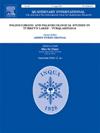Dephasing of islet building between leeward and windward reef-rim sides, Bora Bora Island, Society Archipelago, central South Pacific
IF 1.9
3区 地球科学
Q3 GEOGRAPHY, PHYSICAL
引用次数: 0
Abstract
Defining the timing and accretional mode of low-lying, reef-rim islets over the recent past is a prerequisite for better understanding their future dynamical behaviour in response to rapid rise in sea level and increasing storminess. In high island settings where reliefs locally act as protection against meteorological hazards, establishing the level of vulnerability in the face of global warming remains an important issue. At Bora Bora, a high volcanic island (French Polynesia), internal lithostratigraphy of two selected islets – Motu Tevairoa, leeward, west-north-western side; Motu Tofari, windward, east-north-eastern side – from the barrier-reef rim was reconstructed from four excavated cross-sections. Motu Tevairoa exhibits at the ocean-facing shoreline, pebble-and sand-supported facies abruptly grading into sand-dominated facies inwards. Motu Tofari is dominated by boulder-pebble facies along the oceanic border. U/Th dating was conducted from a collection of 48 coral clasts, in order to reconstruct the timing of islet building. Motu Tevairoa appears to have started to develop by about 2300–2200 cal yr BP from a central islet depocentre laterally extending over time. At the ocean-facing settings, deposition was initiated by about 1600 cal yr BP. By contrast, on Motu Tofari, deposition along the oceanic shoreline, occurred as soon as 3100 cal yr BP. A time lag of approximately 1000 years seems to separate islet accretion between the windward and leeward sides. This strongly suggests that winter storms in the southern hemisphere and those generated from an easterly direction in the northern hemisphere, mid latitudes have played a major role in periodically supplying the north-eastern rim in coral detritus while the western side was occasionally nourished by distant-source swells derived from the north-western sectors. In both settings, the main phases of islet building occurred during the late Holocene sea-level drop. This questions the ability of islets at Bora Bora to adapt to a rapid rise in sea level in the near future.
南太平洋中部,社会群岛,波拉波拉岛,背风和迎风礁缘两侧小岛建筑的退化
在最近的过去,确定低洼的珊瑚礁边缘小岛的时间和增加模式是更好地理解它们未来对海平面快速上升和风暴增加的动态行为的先决条件。在地势高的岛屿环境中,当地的救济起到了防止气象灾害的作用,因此确定面对全球变暖的脆弱程度仍然是一个重要问题。在Bora Bora,一个高火山岛(法属波利尼西亚),两个选定小岛的内部岩石地层- Motu Tevairoa,背风,西北偏西面;Motu Tofari,迎风,东-东北面-从大堡礁边缘重建了四个挖掘的横截面。Motu Tevairoa在面向海洋的海岸线上展示了卵石和沙子支撑的相突然向内转变为沙子主导的相。Motu Tofari主要为沿海洋边界发育的砾卵石相。U/Th是根据收集的48个珊瑚碎屑进行测年的,目的是重建小岛建造的时间。Motu Tevairoa似乎是在距今2300-2200万年左右,从一个横向延伸的中央小岛沉积中心开始发展起来的。在面向海洋的环境中,沉积开始于大约1600 calyr BP。相比之下,在Motu Tofari,沿着海洋海岸线的沉积,早在3100 calyr BP就发生了。大约1000年的时间滞后似乎将岛屿的上风和背风面分开。这有力地表明,南半球的冬季风暴和北半球偏东方向产生的冬季风暴在周期性地向东北边缘提供珊瑚碎屑方面发挥了主要作用,而西侧则偶尔受到来自西北部分的远源涌浪的滋养。在这两种情况下,岛屿形成的主要阶段都发生在全新世晚期海平面下降期间。这就对波拉波拉岛在不久的将来适应海平面迅速上升的能力提出了质疑。
本文章由计算机程序翻译,如有差异,请以英文原文为准。
求助全文
约1分钟内获得全文
求助全文
来源期刊

Quaternary International
地学-地球科学综合
CiteScore
5.60
自引率
4.50%
发文量
336
审稿时长
3 months
期刊介绍:
Quaternary International is the official journal of the International Union for Quaternary Research. The objectives are to publish a high quality scientific journal under the auspices of the premier Quaternary association that reflects the interdisciplinary nature of INQUA and records recent advances in Quaternary science that appeal to a wide audience.
This series will encompass all the full spectrum of the physical and natural sciences that are commonly employed in solving Quaternary problems. The policy is to publish peer refereed collected research papers from symposia, workshops and meetings sponsored by INQUA. In addition, other organizations may request publication of their collected works pertaining to the Quaternary.
 求助内容:
求助内容: 应助结果提醒方式:
应助结果提醒方式:


